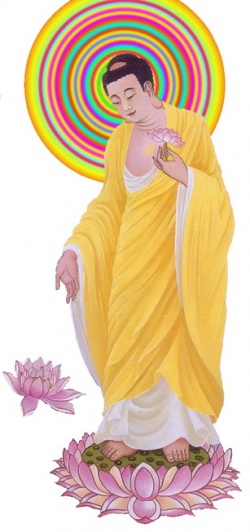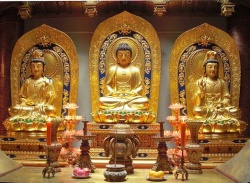The Three Jewels and Five Precepts
Three Jewels:
Despite the differences in the varieties of Buddhism, thereare always the same three cornerstones which are called the ThreeJewels. These are the Buddha, the Dharma which is the teaching ofthe Buddha, and the Sangha, which is the community who follow theteaching.
When a person accepts the Buddhist philosophy and wants tomake it part of their life, the traditional way is to say "Itake refuge in the Buddha, I take refuge in the Dharma, I takerefuge in the Sangha."
The Dharma, the teaching of the Buddha is based on the FourNoble Truths and this is symbolised by the wheel. Originally, theSangha was the monastic community and this was later to includeall those following the Buddhist path.
The first jewel is the Buddha. To take refuge in the Buddha is not to hide inthe safety of a powerful being. Refuge in this situation is more like moving toa new perspective, to a new awareness of the possibility within us all. Bytaking refuge in the Buddha, we align ourselves with the ability to become aBuddha ourselves, to seek the capacity to be awakened to what the Buddhaexperienced. This precious jewel reminds us to find our own Buddha nature.
The Dharma is the path which follows the teaching of the Buddha, and whichwill ultimately lead to awakening. The Dharma teaches us compassion forourselves and others through an understanding of The Four Noble Truths and leadsto a release from fear and ignorance. The path involves embracing the teachingof the Buddha and applying that understanding to everyday life. The Dharma iscalled the second jewel.
The Sangha comprises those who come together in any size group to study,discuss, practice meditation with a desire to help and be helped by that group.The Buddha saw that the interaction with others who are on the path as beingessential for practice. He saw this as being important for ordained monks aswell as those of the general community. The Sangha is the third precious jewel.
In the original teaching and in current Theravadacommunities, the Sangha refers only to the monks,nuns and other ordained teachers. Theconcept of Sangha is more broadly interpreted inmany Mahayana and Western groups to include all those who embrace the Dharma asa community.
Five Precepts
Just as the Three Jewels forms the simple framework for thetransmission of the Buddhist philosophy, the Five Precepts arethe basic ethical guidelines for the followers of the philosophy.
The Five Precepts are not an absolute rigid set of rules, butprovide a practical basis for good, ethical living which willproduce the right environment in which to seek out our owntruths.
The first precept is that of not intentionally killing livingbeings. We step on ants every day, and this isn’t reallywith any lack of care, and I doubt if its possible to avoidoccasionally beating the odd cockroach to oblivion, however, thepremeditated killing of other human and senseless killing ofanimals for sport certainly is not desirable for Buddhists. Theprimary goal of this precept is to develop concern for the safetyand welfare of others and to have compassion for all livingthings.
The second precept is to take only what has been given. Thisis broader than not stealing, as it means returning borroweditems, and not taking unfair advantage even when it is stillwithin the laws of the country. This means that you develop asense of fair play, and generosity towards others.
The third precept often talks about sexual misconduct, but mayalso be interpreted as not misusing the senses. As the strongestdrive after the survival instinct, the sexual drive will dominateour lives and cause much suffering unless directed wisely and skilfully. Living to excess, and in particular excessive eating,also causes grief. This precept encourages us to be content withmore simple lives.
In the fourth precept we are encouraged not to speak falsely,not to lie, slander, misrepresent or to gossip maliciously. This teaches us to speak truthfully and kindly and to have positivemotives when we approach a discussion.
The fifth precept is most important for today’s affluentWestern society, and that is to avoid intoxicants. This includesalcohol, unnecessary drugs, and stimulants such as tobacco andcaffeine. This precept is important to develop rational thinkingand will allow the development of inner clarity needed formindfulness.
As always, the Buddha was compassionate and pragmatic, andrecommended these rather than dogmatically insisting that thesefive precepts were essential. But there is considerable goodsense in each precept and by living with them every day, the wayis then clear to be able to focus on the personal search forenlightened understanding.

